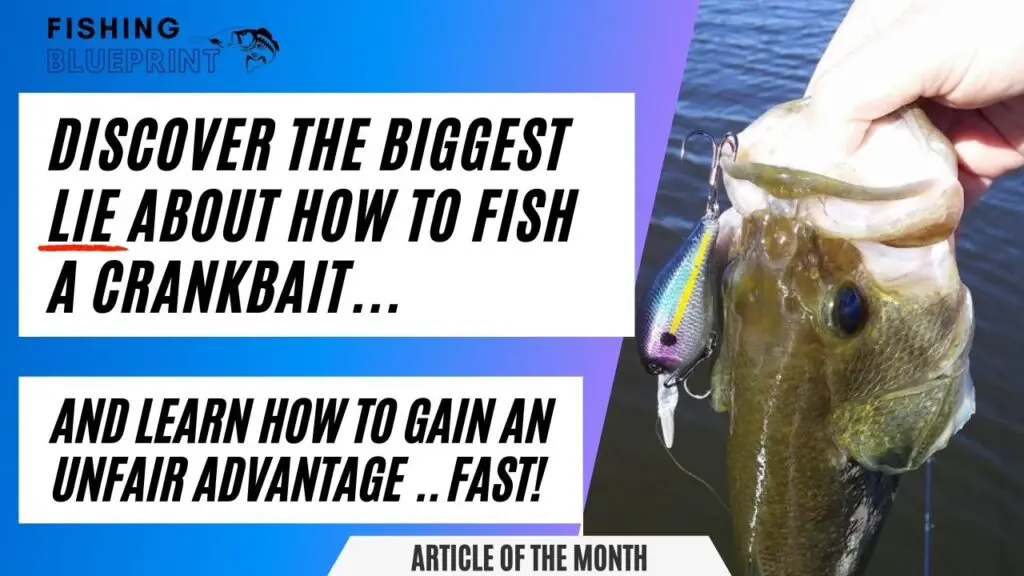Bass Fishing Laydowns | Fishing Laydowns For Bass
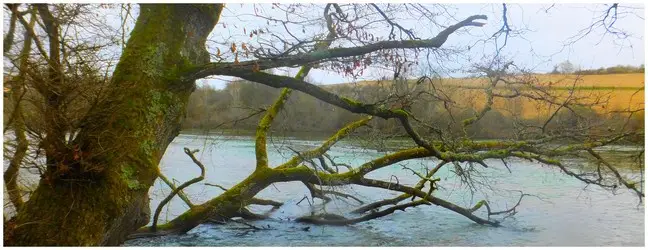
One thing is certain: not all laydowns (also referred to as a fallen tree in the lake) are made equally.
Occasionally, if you visit many large lakes, you can see a hundred laydowns or more! And while it may be a surprise to some, there are certain types of laydowns the fish seem to prefer more than others. Whereas other laydowns may have the occasional fish near them, while others may have no fish at all.
More often than not, after a storm you’ll encounter a row of laydowns spaced closely that you will be at a loss as to which one to use fish first.
The key to bass fishing laydowns are: (1) looking for certain sorts of laydowns that have a greater likelihood to hold fish; (2) knowing how to fish laydowns; and (3) understanding what baits work best.
The old way is to spend hundreds (if not thousands) of hours on the lake fishing and probing every single laydown you come across… but… for the majority of us we don’t have the time or the money to waste going that route.
That’s exactly why I created a new systematic way of fishing laydowns.
Key Takeaways
Thankfully, bass fishing laydowns has become second nature to me now… but that wasn’t always the case. As I spent thousands of hours watching and learning from my mentors, practicing hundreds of hours on the lake… only to fail horribly…
However, over years of honing my skill when ever I had the chance, I slowly started to create my personal laydown fishing blueprint for beginners, which is kinda-like my private set of strategies and tactics. Now whenever I get to the lake and see a laydown, I use my same blueprint and I can quickly pick out the best laydowns that are most likely to hold fish… which allows me to avoid wasting hours of my fishing day…
Question: Would you like to know more? Yes! Great, here are just some of the things you’ll learn in this laydown fishing blueprint:
- Understand why types of laydowns are more likely to hold fish… and… which to avoid as fast as humanly possible!
- How your PC can get you extra bites when you’re on the water!
- How you can legally check to see if the laydown attracts bass… even if the laydown looks like the hundreds of other laydowns in the area… you will get your answer in less than 1 minute… and helps you avoid spending countless hours on the wrong fishing spot!
- The single best way to fish a laydown… this strategy will allow you to catch all the fish… never worry about spooking the rest… even if fish jumps off your hook!
- Learn the best one-two punch for making bass bite when your fishing laydowns – even Mike Tyson would be proud!
If you ever got suckered into fishing the wrong laydown, you know it can be similar to being in a barren ghost town, wasting hours of your day, or forced to deal with a painful arm, or worse!
But wouldn’t it be great
This fishing blueprint, helps you avoid all that… lets get started…
But be warned! Go through the this blueprint slowly and carefully so you don’t miss any tips that could cost you.
Laydown Fishing Primer
If you already know why laydowns are important to fishermen just skip to the next section below, but if you don’t keep reading…
If you are new to bass fishing, you may not be sure what a laydown is in fishing jargon. A laydown is a tree or part of a tree such as a branch or log that has fallen into the water.
Helpful Tip: You may be able to see only a small branch above the water or you may see the complete trunk and branches covered with water. Laydowns require special fishing techniques for bass fishing.
They can be one of the best places in a lake or river to hook into lunkers. Many experienced anglers have their own secrets to catching bass near laydowns.
You can fish laydowns from a fishing boat, a kayak, or from the shore. The basics are similar in all three locations.
This article will reveal the steps needed to successfully catch lunkers when bass fishing a laydown.
Step 1: What Are the Different Types of Laydowns and Why Are They Important?
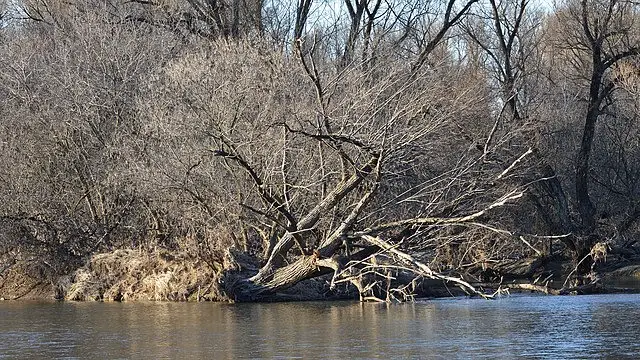
Laydowns can be in many different sizes and shapes. Knowing the various types of laydows is vital because it can give you insight on the ones you need to focus on versus pass over…
Old laydowns – Old laydowns are the carcass of a really old tree. Most of the time you’ll see a large truck and a few branches sticking out the back.
Gnarly laydowns – gnarly laydowns come in a couple of different forms.
The first is more like a large bush and lacks any real trunk and the branches are small in diameter.
The second are the most common laydowns you probably encounter. These types of laydowns have a defined trunk, still have many of the small to medium branches, but lack any green leaves. These are the best laydowns when there is current. The multiple branches break up the current and give the bass a great ambush location.
On the other side of the coin, laydowns with a lot of small branches spread out over the water are not usually good places to fish laydowns because it takes a long time to fish each branch. Many anglers are not willing to spend a lot of time fishing one laydown.
New Laydowns – New laydowns are green trees that have recently been blown over. They still have green leaves that attract bluegill and shad in the summer.
New laydowns with trees that have recently fallen into the water may have fresh green leaves. Small insects that were living on the leaves fall into the water and attract shad and bluegill that eat them.
Wherever the bait is found, bass will be seen since they follow their prey. You can fish newly fallen laydowns with swim jigs, Chatterbait, or other skirted lures that easily glide through these narrow branches.
Step 2: Finding Quality Laydowns at Home First
One of the best ways for anglers to find potential quality laydowns is with Google Maps. This website can show you a birds eye view of all the laydowns on your lake.
Here are what I consider the 3 prime laydown locations for beginners to fish… please note… there are more locations to learn, but I don’t want you to be overwhelmed. With that being said, if you’re going to be bass fishing laydowns, these have a better than average chance of holding bass. And they’re going to be:
- (A) Laydowns that are located at the end of a row.
- (B) Laydowns that are all alone.
- (C) Laydowns in current.
It’s really easy finding laydowns on Google Maps.
- Simply, pull up Google Maps and start looking at your favorite areas on the lake.
- Next, zoom in and verify it’s a dock not anything else (like a boat ramp, or a small pump station).
- Then find the prime dock locations that we previously discussed.
- As you find quality laydowns, save the GPS coordinates and plug it into your fish finder for you to use later.
In this example, we’re going to use Richard B. Russell Lake.
Step 1 – Pull up Google Maps and start looking at your favorite areas on the lake.
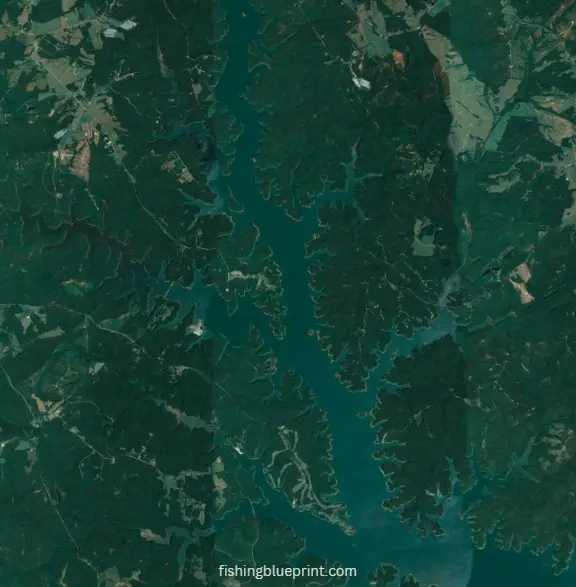
Now say you want to choose to fish Allen Creek (image below

Step 2 – Zoom in and lets start looking for laydowns.
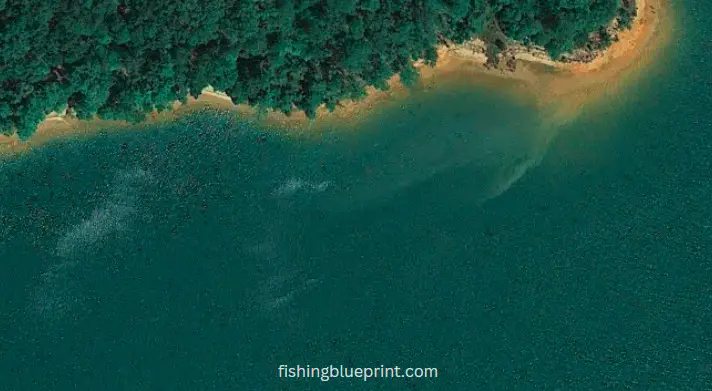
Look closely… This is the mouth of the cove. Do you seen any laydowns?
— Nope. Keep on searching farther into the cove.
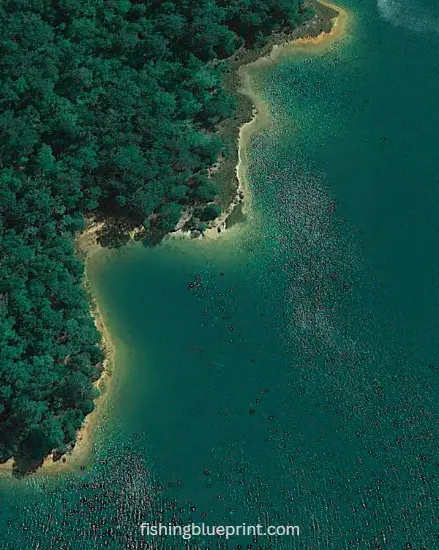
This is farther back into the cove. Do you see any laydows?
— Nope. Keep on searching farther into the cove.
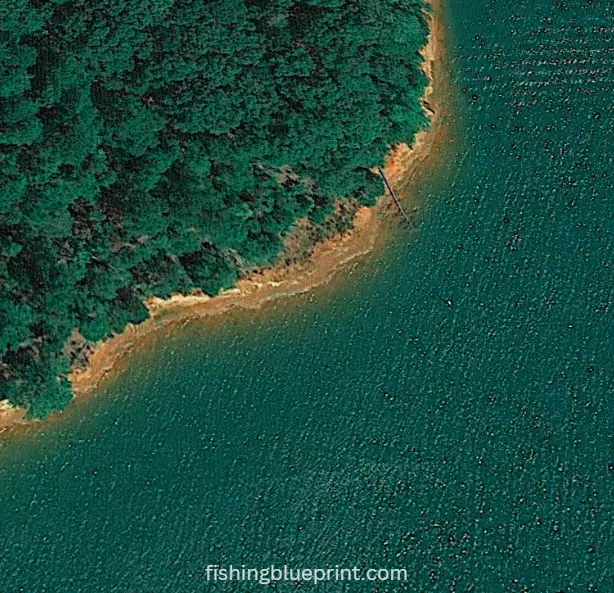
Here’s an helpful example of a laydown at the end of a point. Do you see it?
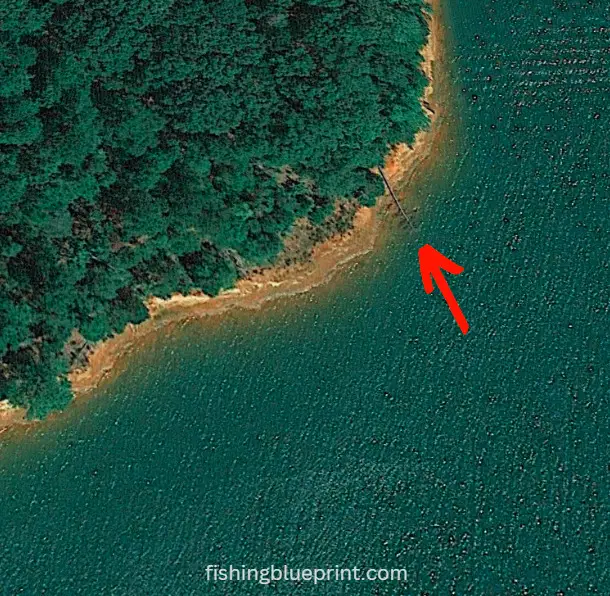
So in a nut shell that’s how you search for laydowns on Google Maps.
Below I’m going to show you what are some of the different types of laydowns what we outlined earlier.
(A) Laydowns that are located at the end of a row.
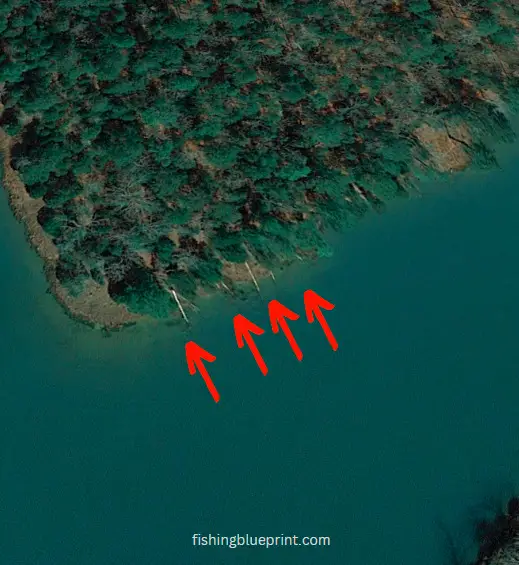
When you pull up to a line of laydows, but the laydown on the end doesn’t have any other structure on the other side of it for 30, 40, or even 50 yards, bass are naturally drawn to it for cover.
So when you motor over to a line of laydowns I would strongly suggest you spend more time on laydows that are on the end.
(B) Laydowns that are all alone.

If there is nothing or very little cover opportunities, the bass will instinctively congregate to the largest structure to give them solitude.
It’s the lone structures like laydowns that fish will congregate underneath, especially if the structure is near deep water.
Bass will pull up out of the deep water and go up shallow during different times of the day and season.
Helpful Tip: "It's the lone structures like laydowns that fish will congregate underneath, especially if the structure is near deep water."
(C) Laydowns in current.

Finding creek channel swings with a laydown on it can be pure gold!
Laydowns in current offer bass cover from overhead predators.
Bass will often jockey and position themselves to the ‘front of the line’ in order for themselves to eat first. They will set up right on the edge facing the current waiting to ambush prey.
Current has additional oxygen that makes bass more comfortable. An angler can use the current to their advantage by allowing it to move their bait along.
Step 3: Identify the Laydown With Your Fish Finder/ Sonar and Scan It
Now that you are on the water it’s time to confirm the quality of the laydown you are fishing. This step is really for laydowns that are in deeper water.
If the laydown of your fishing is in shallow water it can be incredibly difficult to scan.
Step 1) I strongly suggest starting with a side scan first over the deepest section of the tip.
Then if you see anything such as a piece of secondary structure (such as a rock pile or brush pile), or if you scan to detect a school of shad or bass, then I would move on to step 2.
Step 2) After you side scan the laydown, start from the deepest area and drive straight across it. Going back and forth in a zigzag pattern until you get shallow.
Scanning the shallow sections can be a little difficult, but with a little practice scanning the laydown is easy to do.
Below is an example of a laydown you want to fish.
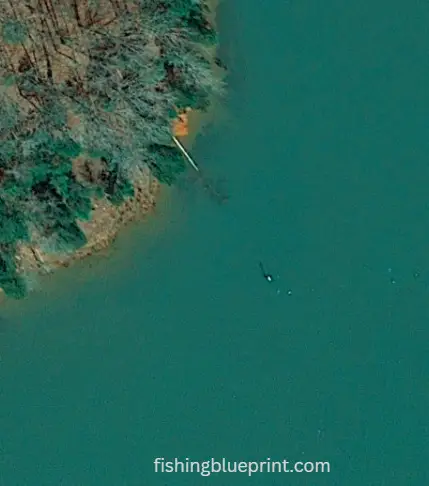
So you get to the lake. Step 1 start side scanning the area…
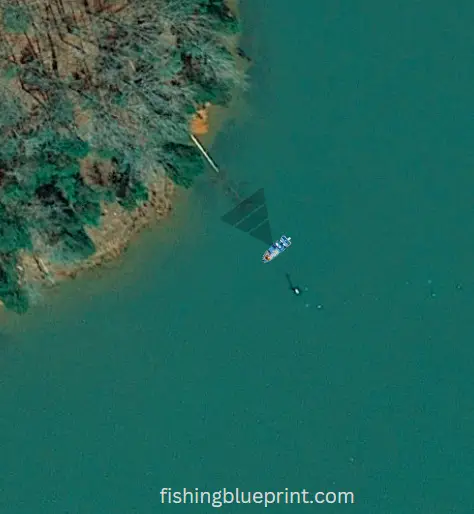
This is what it should look like with your side scan sonar (image below).
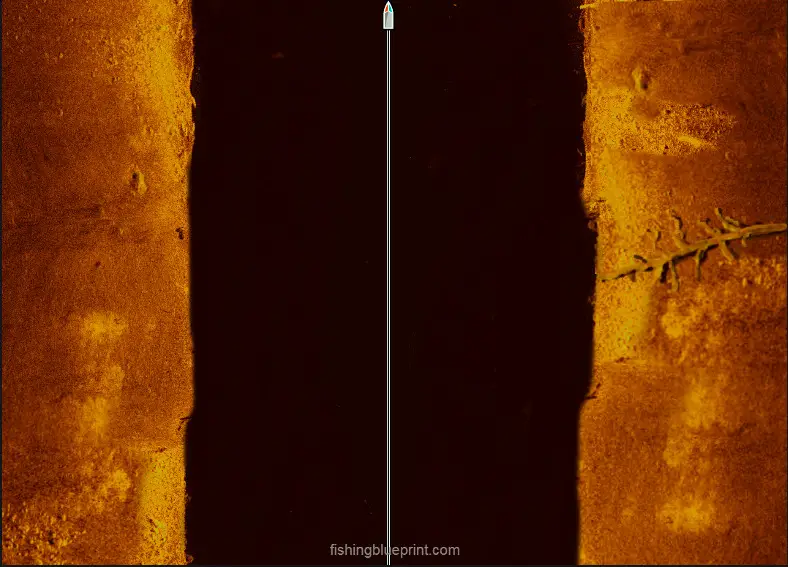
This equipment will also check the depth of water, water temperature, speed, and heading as you drive your boat over the lake.
If you see balls of bait you and the area looks like a good spot, then switch to you structure scan and 2D sonar
Start by driving back and forth cutting directly across the laydown (if it’s long enough and extends into the lake.
As you drive up and over the laydown, the top of the bump will signify the top of the laydown and will gradually get deeper.
It will look like an inverted-V on your electronics.
Finding Active vs. Inactive Fish
Bass will appear as arcs with spaces between each one on a fish finder. They are usually in a horizontal line and do not pile up more than two or three fish above another one.
When scanning a laydown it’s best if you see the bass on top. This signifies the bass are actively feeding. These fish are extremely catchable anytime they are relating directly on top of laydown, best of all you can typically catch them using an assortment of lures.
Look at the images below. This is a downward scan image I recreated to show you what bass look like when they’re relating to the apex of the laydown, they are the large arcs. The smaller dots represent baitfish like shad.
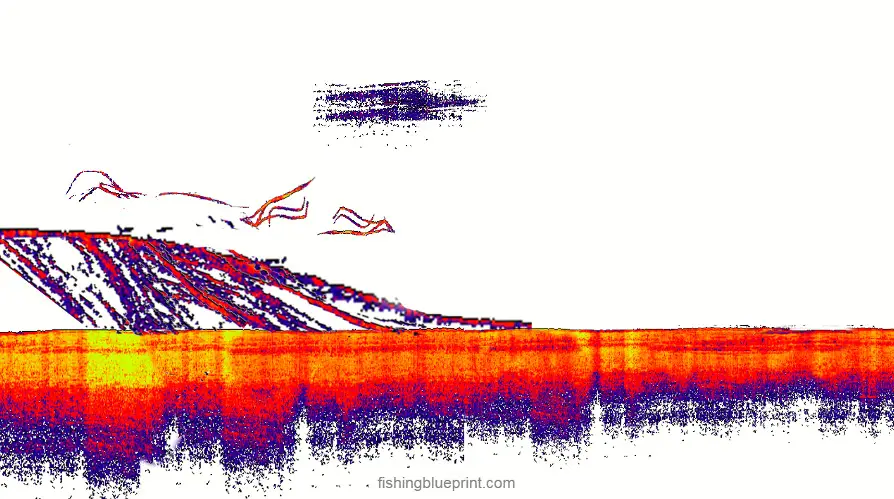
If you see the bass suspending away from the laydown and over the deeper water, or off to the side of the laydown it more than likely means they are not actively feeding. As an illustration in the picture below, they are off to the side of the laydown.

Lastly, if you don’t see any bass but you see a ton of activity of other life such as bait fish, minnows, bluegill, there is a solid chance the bass is hiding in the branches of the laydown.
If the laydown is in shallow water, more than likely you find bass in or under the laydown not on top of it.
Step 4: Fishing The Laydown Systematically
You can become an expert at fishing laydowns for bass by following these easy steps I personally learned from laydown fishing expert Major League Fishing Pro Brian Latimer.
Step 1 – Find a Laydown That Has Everything Needed to Be a Good One
Earlier we discussed what kind of laydowns there are and where are some of the prime laydown spots to find.
A laydown that probably holds bass is in an isolated area. The best area has only a few laydowns, and they are spread apart with space between them.
Helpful Tip: Another factor to show that a laydown is a good one to fish is if it has both shallow water and deep water. This is a perfect laydown where bass can have everything they need.
Bass can feed in the shallow water and swim back to deeper areas under the laydown to feel safe and protected.
The third requirement is that the laydown has branches that are at least one inch in diameter. Bass prefer laydowns with these three characteristics.
Step 2 – Position Your Boat as Far Away as Possible
You will need to position your boat as far away from the layout as possible. Plan to make a long cast to reach the area you are targeting.
The position of your boat can lead to success in fishing bass at laydowns. Quiet your boat and consider that if the water and sky are clear, the bass will see you.
During any environmental conditions, it is important to think of techniques that will work in that weather and water.
Step 3 – Start Fishing on the Outside of the Laydown
The best anglers do not make a cast without first considering the best strategy to use. Throw to the wrong area and some large bass may swim away to escape you.
Always cast on the outside of the laydown first. Start at the end of the tree farthest from the end of the laydown.
If part of the tree is under water and you aren’t sure where the end is, make a good guess. Begin throwing around the edges of the laydown and make your casts from different angles to be sure to fish all areas around ten inches apart.
The largest bass often hide back in the “heart” where they are protected and can easily move out to ambush shad or bluegill. Fish the “heart” of the laydown by working your way to it.
Step 4 – Remember That Laydowns Are Ambush Spots for Bass
Laydowns are ambush spots for bass, so use lures that blend in with the prey the bass are chasing. If you see bass actively feeding in shallow water, use a reaction-style lure like the Z-Man Jack Hammer Chatterbait.
Bass are known to respond to the Jack Hammer. Use a fast presentation and retrieval with this bait.
A 3/8 ounce Jack Hammer vibrates through the water with a back-and-forth motion to get bass’s attention quickly. It slides through cover, so you won’t spend time untangling your line.
Helpful Tip: Don’t give the bass too much time to think about it. This shallow water lure may get a response from bass who do not want to be bothered, and they are hooked into before they realize what happened.
If the bass are in a timid mood and doesn’t want to chase a bait, then I strongly recommend switching to a flipping bait or jig.
If the water is stained-to-dirty many anglers agree that switching to a larger creature bait is the way to fish laydowns. Flipping the lure allows the bait to slide through branches and vegetation without getting caught on tree parts.
The majority of creature bait brands come infused with salt. The salt inspires the bass to hold onto it longer to provide enough time for the angler to set the hook, and it descends at a slower rate down into the water.
Most come around 4-inches long and are available in many colors.
Step 5 – Keep Fishing the Laydown Once You Hook into a Bass
One of the secrets to bass fishing laydowns is to make more than one throw. If you have caught one bass, chances are good that there are more bass hiding under this laydown.
You may be surprised that you hook into a big one when you cast your bait the seventh or eighth time and make a catch. Don’t give up because the bass may be hesitant and somewhat suspicious if you have already caught a bass there.
They may give in and pursue your bait after multiple throws many times.
Another tip is to use another lure such as the topwater baits explained below. Often, changing bait will catch bass’s attention rather than continuing to fish the same bait.
Step 6 – Fishing Laydowns Requires Patience
Another basic that experienced anglers agree on is that the best strategy for fishing bass on laydowns is to be patient. Fishing laydowns takes time as you recast on both sides and work your way from the front to the laydown to the back.
Also, most anglers who have had success with laydowns use medium-heavy to heavy rods. They also use a reel that can be rolled in quickly.
More Bass Fishing Laydowns Tips...
- A good laydown can be in any part of the lake. Not all laydowns hold fish, and if there are only a few laydowns in an area, there is more chance of them having bass around or underneath them.
- As said above, a good laydown is not only in an isolated area. It has branches that are large, usually one inch or bigger.
- Laydowns that are perpendicular to the bank are the best laydowns because they probably have part of the laydown in shallow water and part in deep water.
- Some laydowns are completely submerged under the water, and others have only a branch sticking out of the water surface. Productive laydowns for bass fishing may be a log by itself.
- Laydowns that are in spots where water becomes deeper are often the best ones to target. These areas with water depth changes are known to hide big bass who can move back to the deeper areas after feeding in shallow spots.
- It is also productive to find areas with laydowns that provide shade and hiding spots where bass can wait to attack prey fish. Bass that survive often make these shady spots their homes.
What are the Best Baits For Bass Fishing Laydowns?

When choosing what bait you should you here’s a quick and easy list that helps me:
- Topwater lures, buzzbaits, and frogs in the morning or on cloudy conditions.
- Crankbaits, spinnerbaits, jerkbaits, chatterbaits, underspin jigs, swim jigs, and soft plastic swimbaits, perform well here in breezy conditions or during the midday.
- In contrast, flipping a Texas rig or a weedless Neko rig can be phenomenal when the conditions are calm or the bass are holding close to the rocks.
- Flutter spoons work great in the deepest part of the dock or over any secondary structures directly related to the laydown.
When Is The Best Time of the Day to Fish Laydowns?
Most anglers think that early morning is the best time of the day to fish laydowns, however fishing laydowns in the afternoon when the sun is at its highest is the best. Here’s why…
Bass like the dim light during the early morning and late afternoon, so they feel comfortable coming out and chasing their prey… however… when it’s bright and sunny out they need to hide and ambush unsuspecting prey swimming by.
My Personal Notes: My 2 Biggest Problems with Fishing Laydowns for Bass
One of the biggest problems or frustrations I encountered was deciding which laydown to concentrate on. Some of the lakes I’ve fished have miles of laydowns, so this can be a difficult decision.
As I became more and more successful I started to develop the strategies to choose the best laydowns.
Another issue I encountered was a lack of patience. This was really difficult for me because I have ADD, so picking apart a single laydown was incredibly boring… but… after I learned what laydowns to focus on versus which one to pass up it really helped me out.
Want To Learn Where To Catch More Bass? Checkout These Articles...
- Bass Fishing CREEKS The Easy Way (In Less Than 10 Minutes)
- Warning: Bass Fishing HEAVY GRASS? [15+ Mistakes To Avoid]
- Bass Fishing POINTS in 5 Quick & EASY Steps!
- Complete 5-Step DOCK Fishing Formula
- Bass Fishing LAYDOWNS [Complete Guide + Pictures]
- Little Known Pattern for Fishing TREES for Bass.. Now and Forever
- Complete Formula For BASS FISHING ROCKY BANKS & RIPRAP
- The 5 TRUTHS about Bass Fishing BRIDGES and Avoid Wasting Time On Techniques That Don’t Work!
- Bass Fishing BRUSH PILES To Catch The Most Bass In Minimum Time!
- The 7-step Secret Formula for Bass Fishing LEDGES – Even a Complete Fishing Noob Can Use and Be 100 Times More Potent Than the Best B.A.S.S. Professional!
- The Single Best Guide to Fishing SHELL BEDS… and… Do It Fast!
- 5 Basic Elements Of Fishing HUMPS AND RIDGES No One is Talking About!
- 5 Crucial (and Unusual) Tactics You Must Do When Bass Fishing ROADBEDS!
- Top 25 Summer BANK Fishing Tips (Never Get Skunked Again)
- [EXPERT REVEALS] Bass Fishing In MUDDY WATER Secrets – 27 Tips & Mistakes To Avoid Today!
- 31 Best Tips for Bass Fishing At NIGHT (Complete Guide)
Checkout These Other Summer Fishing Articles...
- Complete 5-Step Formula For BASS FISHING DOCKS
- The 7-step Secret Formula for BASS FISHING LEDGES – Even a Complete Fishing Noob Can Use and Be 100 Times More Potent Than the Best B.A.S.S. Professional!
- Top 25 Summer Bank Fishing Tips (Never Get Skunked Again)
- Bass Fishing In Heavy Grass? [17+ Mistakes To Avoid]
- 7 Top Secret Weedless Bass Lures for Flipping into Heavy Grass -Exposed!
- How To Fish A Crankbait [TOP 10 Essential Secrets To Catching Bass With A Crankbait]
- 15 Best Deep Diving Crankbaits [2023 Buyers Guide – Which to Buy & Avoid]
- Fish a Flutter Spoon The RIGHT way... like the Pros... And Do It TODAY!
- NEW and truly "no brainer" (yet usually overlooked) way to MASTER SOFT PLASTIC PADDLE TAIL SWIMBAITS and increase the amount of bass you catch 100% or more... automatically!
- Top 5 questions and challenges every about hair jig fishing... AND how to overcome common problems most anglers encounter (and then prematurely quit).
- Top 10 Best Jigs For Bass Fishing [Insiders Only]
- Avoid this ONE Texas rig fishing NIGHTMARE - And increase your Texas rig fishing expertise FAST!
- 31 Best Tips for Bass Fishing At NIGHT (Complete Guide)
- 2023 Buyers Guide Best GREEN FISHING LIGHT [LED FISHING LIGHTS Reviews & Tips]
- Dock Lights For Night Fishing [Best Products, Secrets, & Tips]
Other Bass Fishing Articles Just For You...
Funny Fishing Rules, Laws, and Regulations 2025
Crazy Fishing Laws That Will Blow Your Mind! #7 is INSANE! Strange Fishing Regulations and Laws As silly as hook and rod limits may seem,
EXPOSED! How To Use A Spinnerbait The Right Way for 2025
Are You Wondering How To Use A Spinnerbait? Or How To Work A Spinnerbait Over Grass, Logs, or Points? Well, All These Questions Are Answered
EXPOSED! Best Crankbait Colors for 2025 [Which to Buy & Avoid]
What color crankbait to use? Crankbait Color Chart I just love going into a Bass Pro Shops store and just staring at all the walls
Best Underwater Dock Lights For Fishing – 2025 Buyers Guide
Night Dock Light Fishing For Beginners Dear fellow angler, Does this sound like you? You’re someone who loves fishing but just wants to escape the
15 Best Deep Diving Crankbaits [2025 Buyers Guide – Which to Buy & Avoid]
A Complete Buyer’s Blueprint On The Best Deep Diving Crankbaits for Bass, Walleye, or Striped Bass On The Market Today Fishing deep diving crankbaits can
